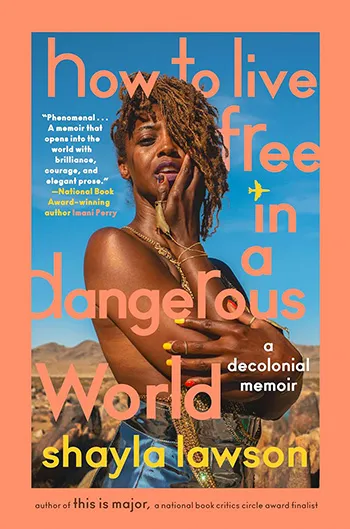
HOW TO LIVE FREE IN A DANGEROUS WORLD: A DECOLONIAL MEMOIR
SHAYLA LAWSON
© 2024 Tiny Rep Books / Penguin
$29.00
303 pages
Minneapolis has always been one of Shayla Lawson's favorite cities, perhaps because they were at one of Prince's first concerts. They weren't born yet, though: they were in their mother's womb. But it was the first of many concerts.
In all their travels, Lawson has noticed that being a Black American has its benefits. People in other countries seem to hold them in higher esteem than do people in America. Still, there's racism – for instance, their husband's family celebrates Christmas in blackface.
Yes, Lawson was married to a Dutch man they met in Harlem – "not Haarlem," Lawson is quick to point out – and after the wedding, they became a housewife, learned the husband's language, and fell in love with his grandmother. Alas, he cheated, and the marriage didn't last. He gave them a dog, which loved them more than the man ever did.
They've been to Spain, and saw a tagline in which a dark-skinned Earth Mother was created. Said Lawson, "I find it ironic, to be ordained a deity when it's been a... journey to be treated like a person."
They've fallen in love with "middle-American drag: it's the glitteriest, because our mothers are the prettiest." They changed their pronouns after a struggle "to define my identity," pointing out that in many languages, pronouns are "genderless." They contemplated Frida Kahlo in Mexico, and thought about their own disability. And they wish you a good trip, wherever you're going.
"No matter where you are," says Lawson, "may you always be certain who you are. And when you are, get everything you deserve."
Crack open the front cover of How to Live Free in a Dangerous World and you might wonder what the heck you just got yourself into. The first chapter is artsy, painted with watercolors, and difficult to peg. Stick around, though – it gets better.
Past that opening, Lawson takes readers on a not-so-little trip, both worldwide and with observant eyes – although it seems, at times, that the former is secondary to that which Lawson sees. Readers won't mind that so much; the observations on race, beauty, and love; the attitudes of others toward America; and finding one's best life are really what take the wheel in this memoir anyhow. Reading this book, therefore, is not so much a vacation as it is a journey of discovery and joy.

